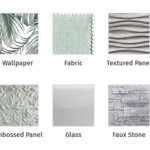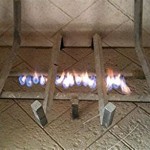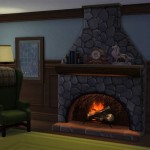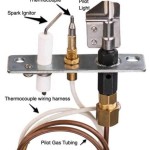Corner Fireplace with Raised Hearth: A Comprehensive Guide
The corner fireplace with a raised hearth represents a popular design choice for homeowners seeking to maximize space and visual appeal. This configuration leverages the often-underutilized corners of a room, transforming them into focal points. The elevated hearth, beyond its aesthetic contribution, offers practical advantages in terms of safety, visibility, and overall functionality. This article will delve into the various aspects of corner fireplaces with raised hearths, covering design considerations, material choices, installation nuances, and safety protocols.
Design Considerations for Corner Fireplaces with Raised Hearths
Planning a corner fireplace with a raised hearth necessitates careful consideration of several design elements. The scale of the fireplace must be proportional to the room size. A fireplace that is too large can overwhelm a smaller space, while one that is too small may appear insignificant in a larger area. Furthermore, the architectural style of the fireplace should complement the existing design of the home. Integrating elements like brick, stone, tile, or wood paneling can create a cohesive visual statement.
The positioning of the fireplace within the corner is also crucial. While centering the fireplace directly within the corner is a common approach, variations exist. Offsetting the fireplace slightly can create asymmetry, adding visual interest. The angle at which the fireplace faces outward impacts the viewing angle from different areas of the room. Consider the primary seating arrangements when determining the optimal orientation.
The height of the raised hearth is another essential design factor. A lower hearth, perhaps one or two steps high, provides a subtle elevation while maintaining accessibility. A higher hearth, potentially functioning as extra seating, creates a more significant visual distinction. Building codes often regulate the height and depth of raised hearths, so adherence to these regulations is paramount. The overall design should consider accessibility for individuals with mobility limitations, potentially incorporating ramps or minimizing the step height.
Furthermore, consider the surrounding wall space. Integrating built-in shelving, cabinetry, or media centers around the fireplace can enhance its functionality and aesthetic appeal. The design should also consider the placement of electrical outlets for convenient operation of media devices or other electronic equipment. Proper lighting, both accent and task lighting, is crucial for highlighting the fireplace and creating a warm, inviting ambiance.
Material Selection for Corner Fireplaces and Raised Hearths
The selection of materials significantly impacts the appearance, durability, and overall cost of a corner fireplace with a raised hearth. Common materials include brick, stone, tile, concrete, and various types of wood. Each material offers unique aesthetic qualities and performance characteristics.
Brick is a classic choice, offering durability, fire resistance, and a timeless appearance. Brick can be used for both the fireplace surround and the raised hearth, creating a cohesive look. The color and texture of the brick can be varied to suit different architectural styles. Stone, whether natural or manufactured, provides a more rustic and textured appearance. Stone veneer is a lighter and more cost-effective alternative to solid stone, offering a similar aesthetic appeal. The selection of stone should consider its durability and resistance to heat.
Tile offers versatility in terms of color, pattern, and texture. Tile can be used for the fireplace surround, the raised hearth, or both. Ceramic, porcelain, and natural stone tiles are all suitable options. The slip resistance of the tile should be considered, particularly for the raised hearth, to prevent accidents. Concrete, either poured in place or precast, offers a modern and industrial aesthetic. Concrete can be stained or textured to create a customized appearance. It is durable and fire-resistant, making it a suitable material for both the fireplace and the hearth.
Wood can be used for mantelpieces, shelving, and other decorative elements around the fireplace. However, wood should be kept a safe distance from the firebox to prevent combustion. Fire-resistant sealants and treatments can enhance the safety of wood components. The choice of wood species should consider its durability and aesthetic appeal. Hardwoods like oak and maple are more durable than softwoods like pine. The selection of materials should also align with the overall budget for the project. Some materials, like natural stone, are more expensive than others, like brick or tile veneer.
Installation Nuances and Building Codes
The installation of a corner fireplace with a raised hearth requires careful planning and execution. It is often advisable to consult with qualified professionals, such as contractors and masons, to ensure that the installation complies with local building codes and safety regulations. Permits may be required before commencing the work, and inspections may be necessary throughout the installation process.
The foundation of the fireplace is crucial for its stability and longevity. The foundation must be able to support the weight of the fireplace and the raised hearth. In some cases, reinforcing the existing floor may be necessary. The firebox, which is the chamber where the fire burns, must be constructed of fire-resistant materials, such as firebrick or cast iron. The dimensions of the firebox must be appropriate for the size of the fireplace and the type of fuel being burned.
The chimney is responsible for venting smoke and gases away from the home. The chimney must be properly sized and constructed to ensure adequate draft. Building codes often specify the minimum height of the chimney above the roofline. The chimney should also be lined with a fire-resistant material, such as clay tiles or stainless steel, to protect the surrounding structure from heat and corrosion. Regular chimney inspections and cleaning are essential to prevent chimney fires.
The installation of a raised hearth must comply with building codes regarding its height, depth, and proximity to combustible materials. The hearth must extend a sufficient distance beyond the firebox to protect the floor from sparks and embers. Non-combustible materials, such as brick, stone, or tile, must be used for the hearth. The installation of any gas lines or electrical wiring must be performed by qualified professionals and must comply with all applicable codes and regulations. Furthermore, clearances to combustible materials must be strictly adhered to. These clearances dictate the minimum distances between the fireplace and any flammable materials, such as wood framing or furniture.
Proper ventilation is critical for ensuring safe and efficient operation of the fireplace. Adequate air supply is necessary for combustion, and proper venting is essential for removing smoke and gases. The installation should consider the location of air vents and the design of the chimney to ensure proper ventilation. Furthermore, carbon monoxide detectors should be installed in the home to alert occupants of any potential carbon monoxide leaks.
Safety Protocols for Corner Fireplaces with Raised Hearths
Operating a corner fireplace with a raised hearth safely requires adherence to specific safety protocols. These protocols are designed to prevent fires, carbon monoxide poisoning, and other potential hazards. Regular maintenance and inspections are crucial for ensuring the safe operation of the fireplace.
A fire screen or mesh curtain should always be used when the fireplace is in operation. This prevents sparks and embers from escaping the firebox and igniting nearby materials. Keep flammable materials, such as furniture, curtains, and rugs, a safe distance from the fireplace. The manufacturer's recommendations for clearances should be strictly followed.
Only burn approved fuels in the fireplace. Wood-burning fireplaces should only burn seasoned hardwood. Burning softwoods or treated wood can produce excessive smoke and creosote buildup in the chimney. Gas-burning fireplaces should only burn natural gas or propane, as specified by the manufacturer. Never use flammable liquids, such as gasoline or kerosene, to start a fire.
Regular chimney inspections and cleaning are essential for preventing chimney fires. A qualified chimney sweep should inspect the chimney annually and clean it as needed. Creosote, a flammable byproduct of wood combustion, can accumulate in the chimney and increase the risk of a chimney fire. Carbon monoxide detectors should be installed in the home, particularly near sleeping areas. Carbon monoxide is a colorless and odorless gas that can be deadly. Test the carbon monoxide detectors regularly to ensure they are functioning properly.
Never leave a fire unattended. Extinguish the fire completely before leaving the room or going to bed. Use a fireplace poker and shovel to ensure that all embers are extinguished. Dispose of ashes properly in a metal container with a tight-fitting lid. Store the container outside, away from combustible materials. Educate all household members, especially children, about fireplace safety. Supervise children closely when the fireplace is in operation. Consider installing a fireplace gate or barrier to prevent children from getting too close to the fire.
Understand the proper operation of any gas fireplace components, including pilot lights and control valves. If you smell gas, immediately turn off the gas supply and evacuate the home. Contact a qualified gas technician to inspect the fireplace and repair any leaks. By adhering to these safety protocols and maintaining the fireplace properly, homeowners can enjoy the warmth and beauty of a corner fireplace with a raised hearth safely and responsibly.

Gas Fireplace Classic Raised Hearth My Style Corner Remodel

The Corner Gas Fireplace A Great Way To Maximize Your Space

Corner Fireplace With Raised Hearth Home

Result For Free Standing Fireplace With Corner Raised Hearth Wood Stove Home

Corner Fireplace With Bucks County Ledgestone Alder Cap And Raised Stone Hearth Tile Farmhouse Cottage

Tipperary Brown Corner Fireplace Coolestone Stone Importers Suppliers Masonry Tyrone Northern

Corner Fireplace Tile Surround

Stone Corner Fireplaces Cornerstones Of A Room
Corner Fireplace Ideas

Corner Fireplaces Give Rooms A Design Edge








